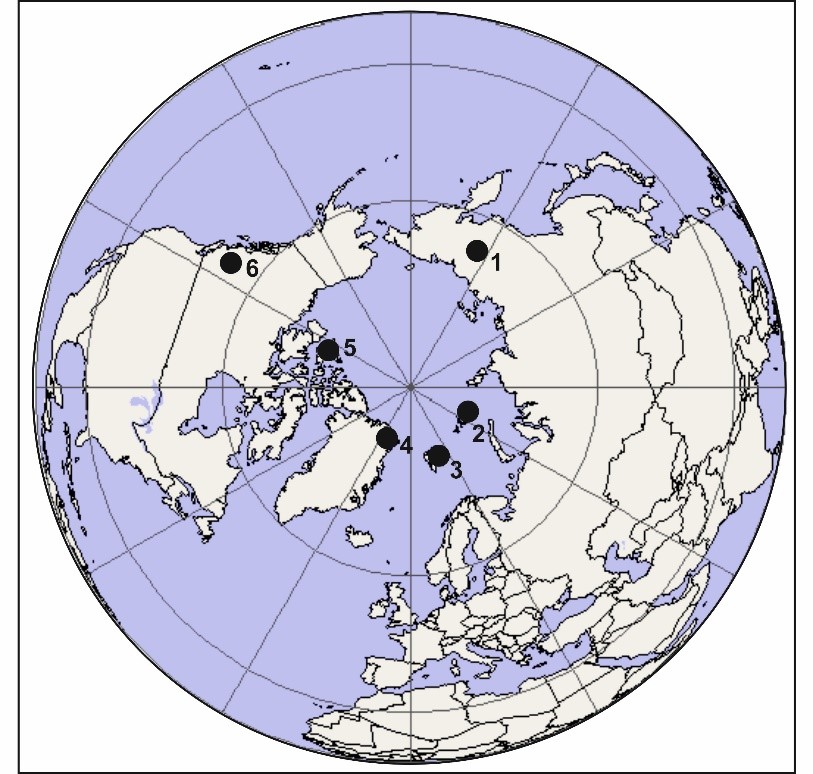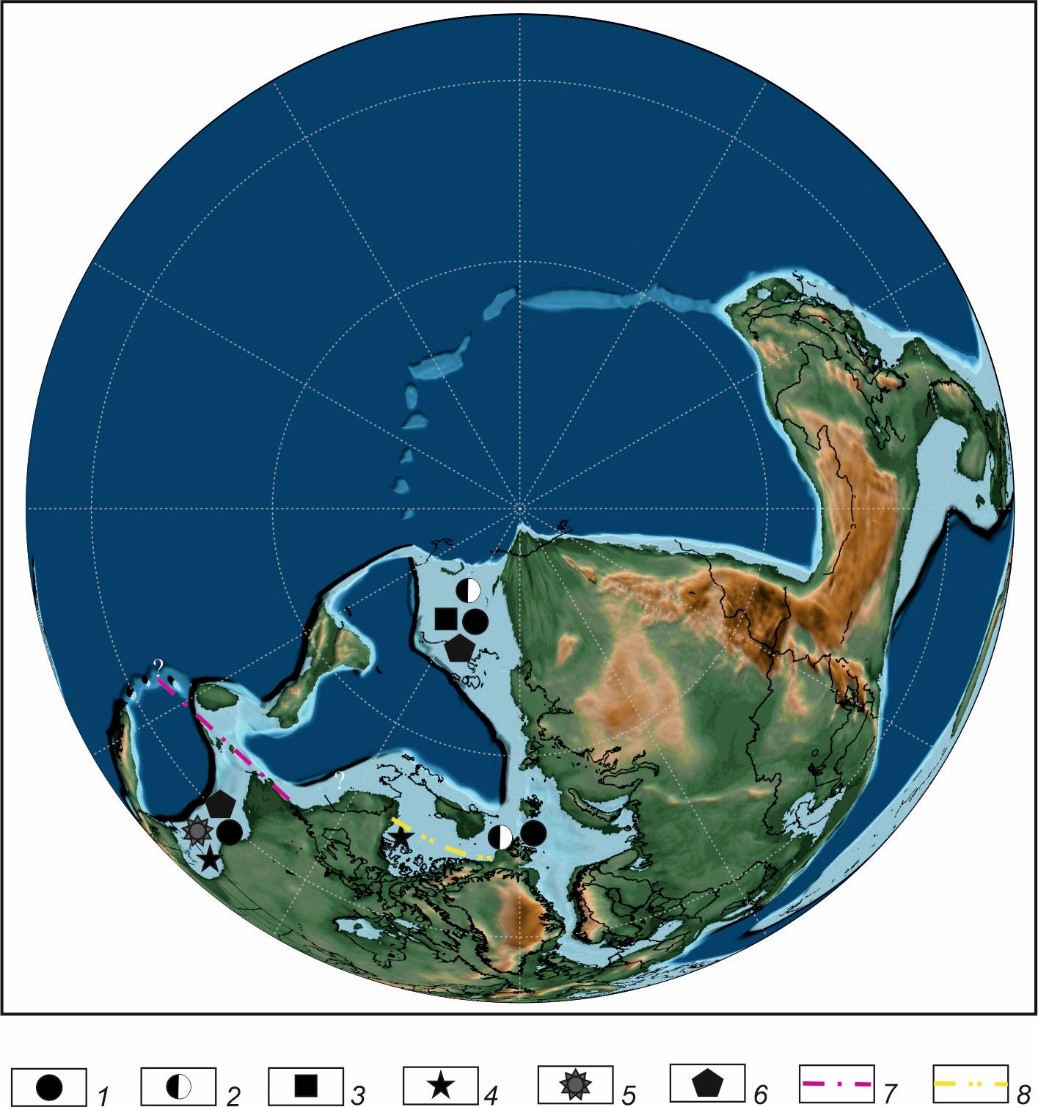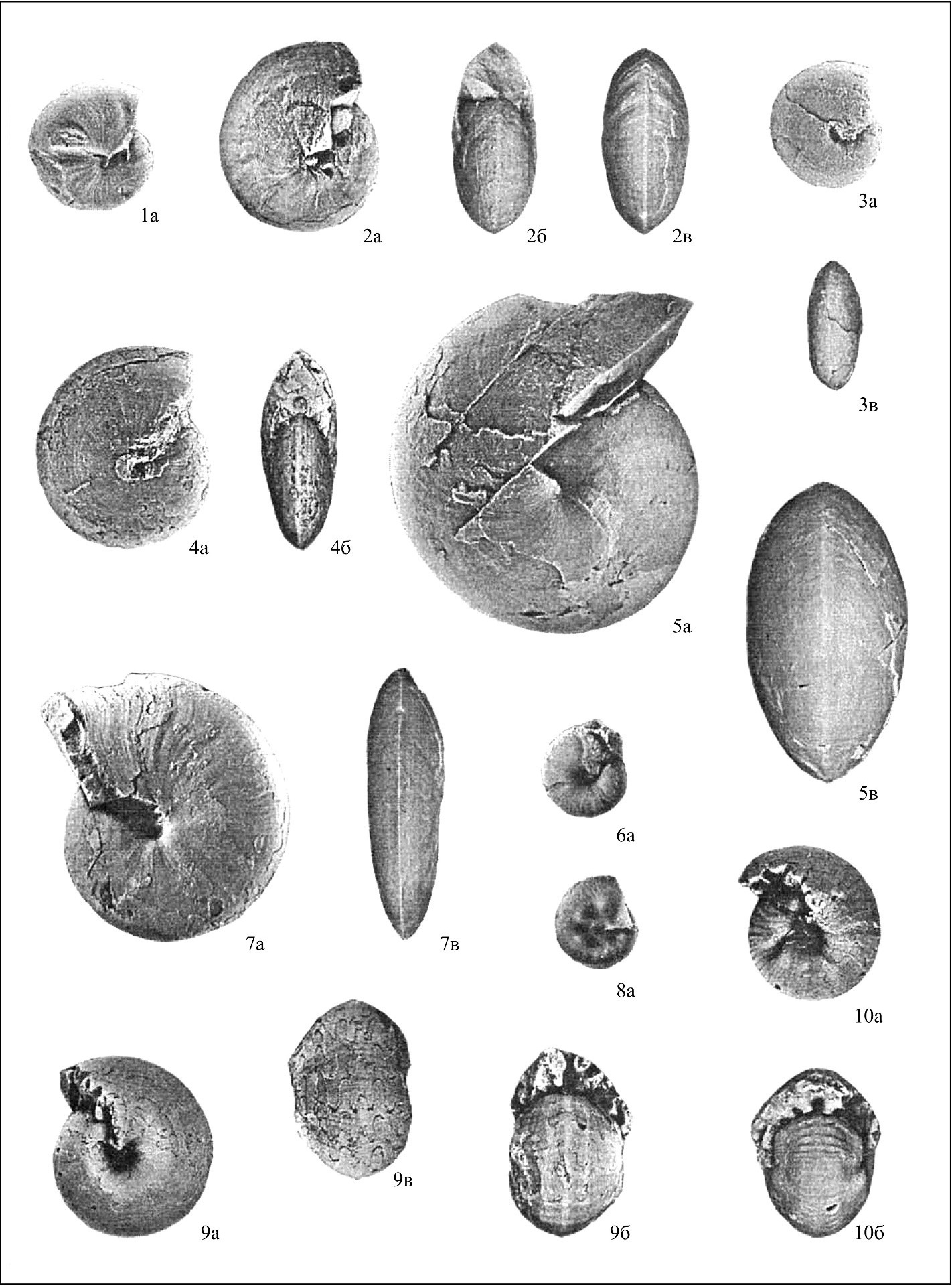Ammonoidea, which evolved about 416 million years ago, were once the most abundant animals of the ancient seas. They represent one of the groups of fossil cephalopods that inhabited marine basins over several geological periods. Their earliest finds are attributed to Devonian deposits. Ammonoids almost completely disappeared during the Cretaceous-Paleogene extinction event (66 million years ago), however individual genera are assumed to have survived it and became extinct as late as in the Danian of the Paleocene Epoch (about 65 million years ago).
Relevance of the research
The study of the spatial distribution of various groups of marine invertebrates in the geological past and the analysis of the dynamics of their geographic differentiation over time are crucial for understanding both the patterns of their evolution and the history of marine basin development.
Thus, identification of paleobiogeographic ecotone zones with mixed fauna composed of elements from different paleobiochores allows resolving the issue of Boreal-Tethyan correlation of deposits. These studies are particularly relevant for critical periods in the evolutionary history of Triassic ammonoids, specifically during the Ladinian Age of the Middle Triassic .
The Ladinian Age spans the time between 241.5 Ma and ~237 Ma (million years ago). A slowdown in evolutionary rate of ammonoids which was observed during this period resulted in a decrease in the total number of their genera.
Alexey Konstantinov, D Sc (geol.-mineral.), lead research scientists at the Laboratory of Mesozoic and Cenozoic Paleontology and Stratigraphy, IPGG SB RAS, suggests that a sharp reduction in the diversity of ammonoids during the Ladinian stage of their development as compared to the antecedent Anisian Age (246.7 – 241.4 mln years) may have been global in nature, since the ammonite species reduced dramatically both in the Boreal (cold) and Tethyan (warm) marine basins, ― he says.
The research conducted at IPGG SB RAS will contribute to the analysis of inherent features of the cephalopods, ammonites in particular, which were a major part of the marine life during this intriguing time period.
Main achievements
In his recent work, A.G. Konstantinov, based on modern paleontological and biostratigraphic data of the Boreal Triassic, revised and refined the taxonomic composition and distribution of Ladinian ammonoids across various regions of the Boreal Realm (Northeast Asia, British Columbia, the Canadian Arctic Archipelago, northern Greenland, Svalbard, and Franz Josef Land).

Circumpolar and adjacent regions of the Northern Hemisphere, which were part of the Boreal Paleobiogeographic Realm in the Ladinian Age: 1 – Northeast Asia; 2 – Franz Josef Land; 3 – Svalbard; 4 – northern Greenland; 5 – Canadian Arctic; 6 – British Columbia.
The zonal correlation on ammonoids of Ladinian deposits carried for these regions provided a chronological basis for comparative analysis of coeval ammonoid faunas.
The IPGG SB RAS researchers have analyzed the taxonomic composition and stratigraphic distribution of Ladinian ammonoids in various regions of the Boreal paleobiogeographic Realm.
The qualitative and quantitative comparative analysis conducted for Boreal ammonoid assemblages including six phases (oleshkoi, constantis, krugi, maclearni, combined macconnelli and lindstroemi; and tenuis) of the Ladinian Age, along with the time of formation of Stolleyites terminalis beds. This provided grounds for revising previous conceptions of the dispersal patterns of Boreal ammonoids, the boundary between the Boreal and Tethyan realms, the timing of the differentiation of the Siberian and Canadian provinces within the Boreal Realm, and the changes in their boundaries over time.
Major migration routes of ammonoidea
The separation of the Canadian Province of the Boreal Realm occurred at the end of the constantis Phase due to the penetration of trachyceratids (genus Protrachyceras) into the paleobasins of the Canadian Arctic Archipelago.

Distribution of Ammonoid genera and paleobiogeographical zoning in the Boreal Realm during the constantis Phase. Legend: 1 – Tsvetkovites, Arctoptychites; 2 – Indigirophyllites; 3 – Arctogymnites; 4 – Protrachyceras; 5 – Tuchodiceras, Proarcestes, Monophyllites; 6 – Gymnites; 7 – border (presumptive) of the paleobiogeographic ecotone zone and the Canadian Province of the Boreal Realm; 8 – border (presumptive) of the Canadian and Siberian provinces of the Boreal Realm. Cartographic basis here and below: polar projection of the paleogeographic map from [Scotese, 2021]
Starting from the maclearni Phase, this genus also penetrated into the Svalbard paleobasins, which was followed by the introduction of additional Tethyan forms (Daxatina, Paracladiscites) from the macconnelli and lindstroemi phases. This initially expanded the Canadian province and subsequently transformed these paleowaters into a transitional ecotone zone between the Boreal and Tethyan realms. The paleobasins of Northeast Asia constantly belonged to the Siberian Province of the Boreal Realm throughout the Ladinian Age. The paleowaters of British Columbia initially belonged to the transitional ecotone zone between the Boreal and Tethyan realms during the interval of matutinum – poseidon phases but later became part of the Tethys Ocean.
Some groups of ammonoidea (rachyceratids and cladiscitidae) penetrated into the Canadian Province, while other groups (gymnitids and lobitids) into the Siberian Province of the Boreal Realm from the Tethys Ocean, which occurred against the oncoming (throughout the Ladinian) southward dispersal of Boreal tsvetkovitids and nathorstitids, into ecotonal and Tethyan paleowaters of British Columbia.

Ammonoidea of the family Nathorstitidae (Upper Ladinian) from paleobasins of Northeast Asia: Fig. 1, 2 ̶ Indigirites krugi Popow, 1946; Fig. 3, 4 ̶ Nathorstites maclearni Tozer, 1994; Fig. 5, 6 ̶ Nathorstites macconnelli (Whiteaves, 1889); Fig. 7, 8 ̶ Stolleyites tenuis (Stolley, 1911); Fig. 9, 10 ̶ Nathorstites lindstroemi Boehm, 1903.
These migrations were likely to have been influenced and controlled by the ammonoids’ lifestyle and their ability to inhabit a broader or narrower range of marine basin depths, rather than by the presence of circum-polar currents alone.
The researcher marks a notable difference existing in the morphology of Tethyan ammonoids that migrated into the Canadian and Siberian provinces of the Boreal Realm. In the Canadian province, forms with well-developed ornamentation and evolute shells predominantly migrated from the Tethys Ocean, whereas in the Siberian province, forms with smooth evolute platyconic or smooth involute pachyconic shells were more common. Similarly, ammonoids migrating southward from Boreal paleowaters had smooth or weakly sculptured involute oxyconic or subdiscoconic shells.
– The temperature barrier as a limiting environmental factor had a lesser influence on the distribution of ammonoids with smooth or weakly-sculptured shells, capable of withstanding great depths, assumingly inhabited deep shelf environments and dwelled near the boundary of the shelf and bathyal slope, ―the researcher emphasized. ― In contrast, strongly-sculptured trachyceratids which inhabited shallow waters required specific habitat conditions. The penetration of trachyceratids into the western part of the Boreal Realm may have been associated with the gradual shallowing of the Boreal basin and the expansion of shallow-shelf environments during the late Ladinian age.
The research was supported by project FWZZ-2022-0004.
Published by IPGG Press Service
Illustrations provided by A.G. Konstantinov
For more detail, please see the article by A.G. Konstantinov at http://www.ipgg.sbras.ru/ru/science/publications/publ-geographic-differentiation-of-boreal-ammonoids-6742756-2025 A.G. Konstantinov (2025). GEOGRAPHIC DIFFERENTIATION OF BOREAL AMMONOIDS IN THE LADINIAN AGE (Middle Triassic). Russian Geology and Geophysics, vol. 66 ( 6), 775-789.